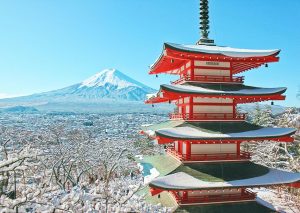Japan, known for its rich cultural heritage, breathtaking landscapes, and unique seasonal beauty, transforms into a winter wonderland from December to March. While many travelers flock to Japan in spring for cherry blossoms or in autumn for the fiery foliage, winter offers a completely different — and equally magical — experience.
From snow-covered mountains and steaming hot springs to dazzling illumination events and vibrant festivals, Japan in winter is a destination that combines natural beauty with deep-rooted traditions. Whether you’re a skier, foodie, or cultural explorer, winter in Japan has something to offer.
Winter Climate in Japan
Japan’s geography stretches over a long vertical axis, giving it a variety of climates. Generally, winter in Japan runs from December to February (sometimes into early March), but the experience varies widely depending on the region:
-
Hokkaido (north): Cold and snowy, with heavy powder snow ideal for skiing and snowboarding.
-
Tohoku and the Japan Alps: Also known for deep snow, scenic winter landscapes, and historic hot spring towns.
-
Tokyo, Kyoto, Osaka (central Japan): Cool but rarely snowy; mild winter perfect for sightseeing.
-
Kyushu, Shikoku, Okinawa (south): Milder winter temperatures, sometimes even warm and springlike in Okinawa.

Snowy Landscapes and Winter Sports
Japan’s northern regions, particularly Hokkaido and Nagano, are world-renowned for their winter sports.
🏂 Skiing and Snowboarding:
-
Resorts like Niseko, Furano, and Rusutsu in Hokkaido offer some of the best powder snow in the world, attracting international skiers and snowboarders.
-
In Honshu, places like Hakuba Valley (Nagano) and Nozawa Onsen combine great slopes with charming onsen (hot spring) villages.
❄️ Snow Festivals:
-
The Sapporo Snow Festival (early February) transforms the city into a frozen art gallery, with massive snow and ice sculptures that glow beautifully at night.
-
Otaru Snow Light Path offers a romantic setting, where canals and streets are lined with hundreds of glowing lanterns.
Cultural Experiences Unique to Winter
Winter isn’t just about snow — it’s also about experiencing Japanese culture in a seasonal way.
♨️ Onsen (Hot Springs):
There’s nothing quite like soaking in an outdoor hot spring while snowflakes fall around you. Famous onsen towns like Kusatsu, Yufuin, and Ginzan Onsen are especially enchanting in winter.
🐵 Jigokudani Snow Monkeys:
In Nagano, you can visit the Jigokudani Monkey Park, where wild Japanese macaques bathe in natural hot springs, surrounded by snowy landscapes.
🛕 New Year’s Celebrations:
New Year (Shōgatsu) is Japan’s most important holiday, celebrated with shrine visits (hatsumode), traditional food (osechi ryori), and festive decorations.
Winter Food Delights
Japanese winter cuisine is all about warming the body and soul.
🍲 Nabe (Hot Pot):
Regional hot pot dishes like chanko nabe (sumo stew), sukiyaki, and shabu-shabu are perfect for cold nights.
🍶 Warm Sake:
Enjoy hot sake alongside hearty meals, especially in snowy towns and cozy izakayas (Japanese pubs).
🍡 Seasonal Street Foods:
At winter festivals, you’ll find delicious street snacks like roasted sweet potatoes, grilled mochi, and steaming bowls of ramen.
Winter Illuminations and Festivals
Even in urban areas, winter in Japan is celebrated with light and color.
✨ Winter Illuminations:
Cities like Tokyo, Osaka, and Kobe light up with dazzling LED displays that draw crowds of visitors. Famous spots include:
-
Tokyo Midtown & Roppongi Hills (Tokyo)
-
Osaka’s Midosuji Illuminations
-
Kobe Luminarie — a stunning memorial illumination honoring victims of the 1995 Great Hanshin Earthquake.
🎊 Traditional Festivals:
In addition to the snow festivals, Japan hosts unique winter matsuri (festivals), such as the Yokote Kamakura Festival in Akita, where people build snow huts (kamakura) and light candles inside for a magical atmosphere.
Travel Tips for Japan in Winter
✅ Pack Warm Clothes: While central and southern Japan are mild, northern regions are extremely cold. Bring thermal layers, waterproof boots, gloves, and a hat, especially if you visit snowy areas.
✅ Book Early for Ski Resorts: Japan’s ski resorts are popular among international travelers, so accommodations fill up fast.
✅ Rail Passes: The Japan Rail Pass is a cost-effective way to travel across regions, even in winter. Be aware, however, that heavy snow can occasionally cause train delays in some areas.
✅ Enjoy Off-Season Benefits: Major cities like Kyoto and Tokyo are less crowded in winter compared to spring or autumn, making it a great time to explore temples, shrines, and museums.
Why Visit Japan in Winter?
Visiting Japan in winter gives you a chance to experience a side of the country many travelers miss. Whether it’s carving through fresh powder, soaking in a steaming onsen, tasting seasonal dishes, or marveling at illuminated festivals, winter in Japan offers a unique and unforgettable adventure.
For photographers, it’s a season of stunning contrasts — from snow-blanketed villages like Shirakawa-go to the majestic sight of Mount Fuji framed by crisp, clear skies. For families, it’s a time of fun and magic, with everything from ice skating to visiting Disneyland under twinkling winter lights. And for cultural travelers, it’s an opportunity to experience Japan’s traditions in their purest, most peaceful form.
Final Thoughts
Japan in winter is much more than just a cold season — it’s a wonderland where nature, tradition, and modern charm come together. Whether you’re seeking adventure on the slopes, relaxation in a hot spring, or cultural immersion in winter festivals, Japan has something special waiting for you.